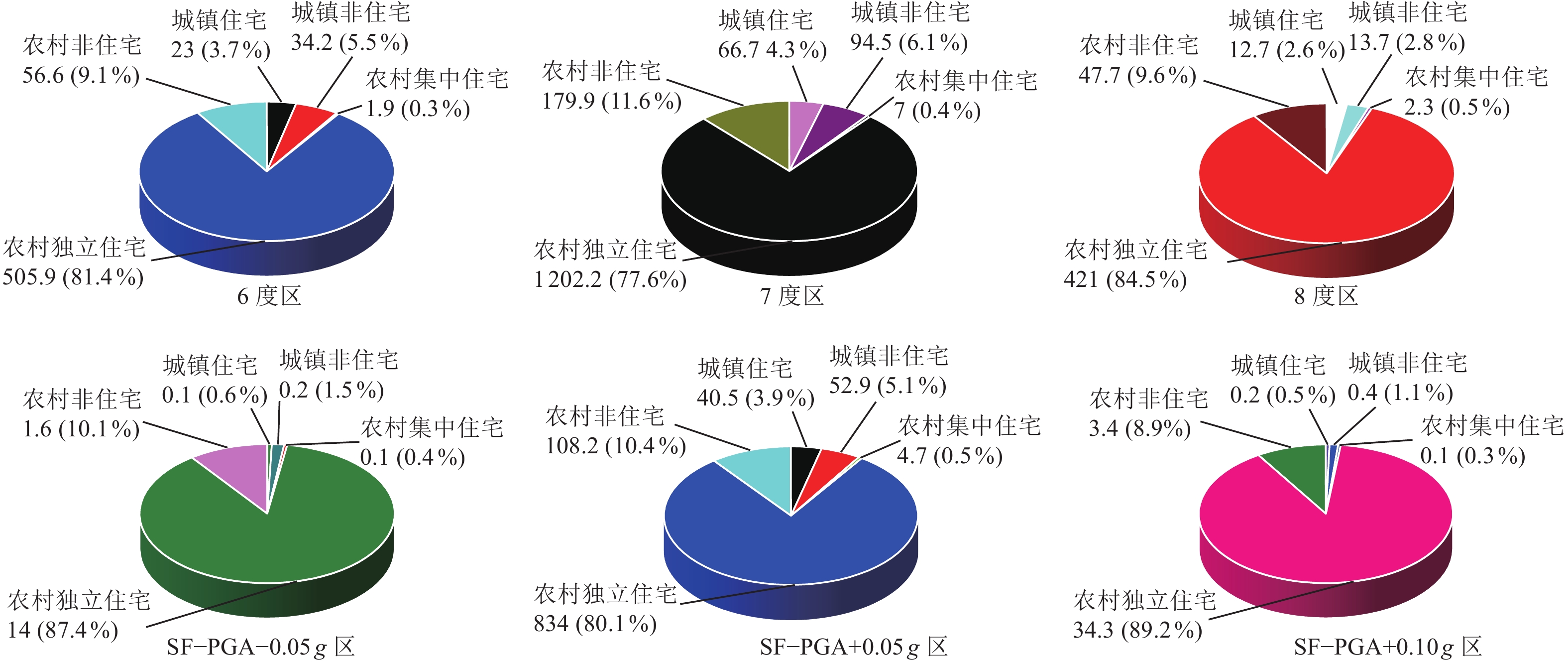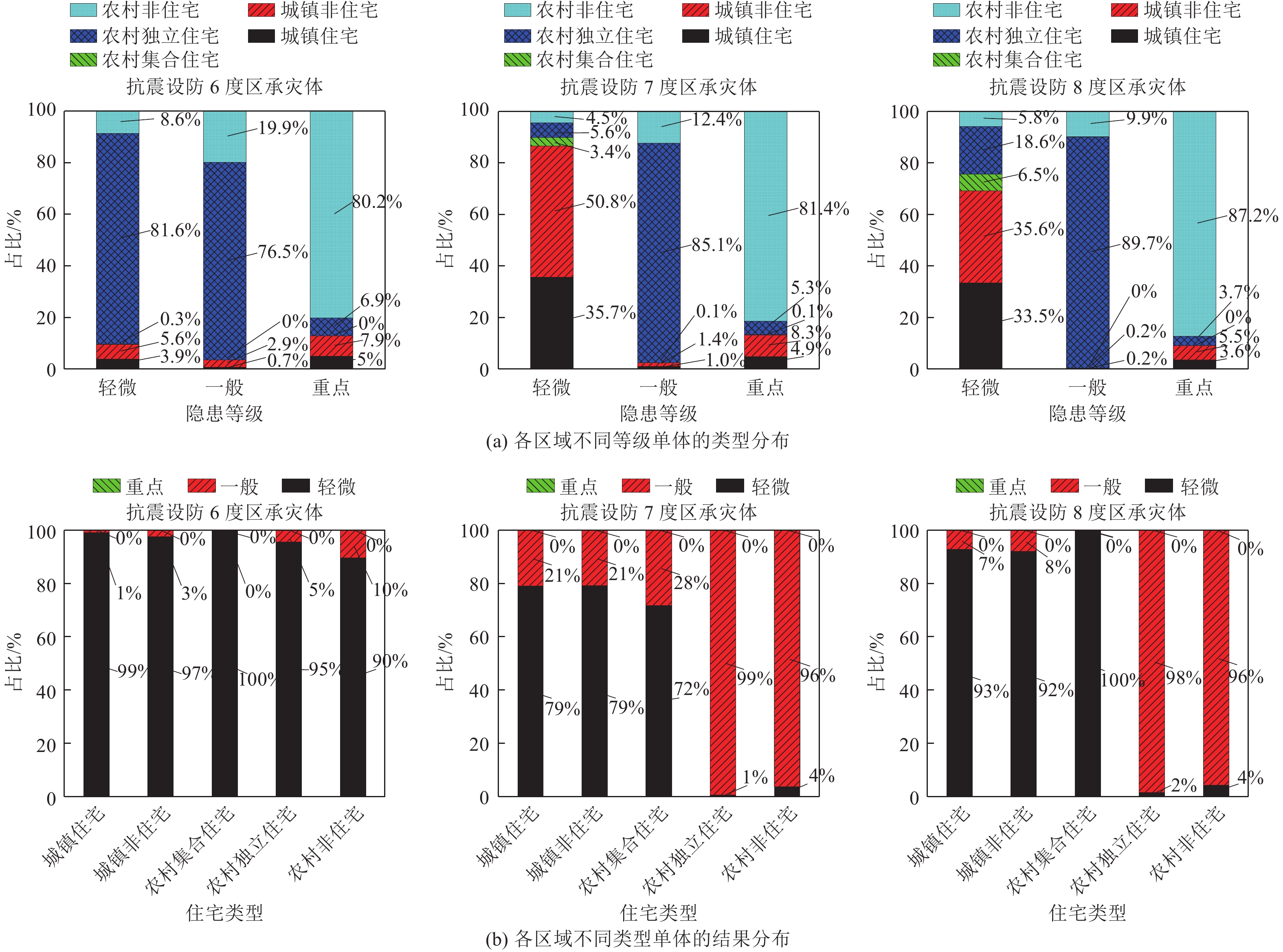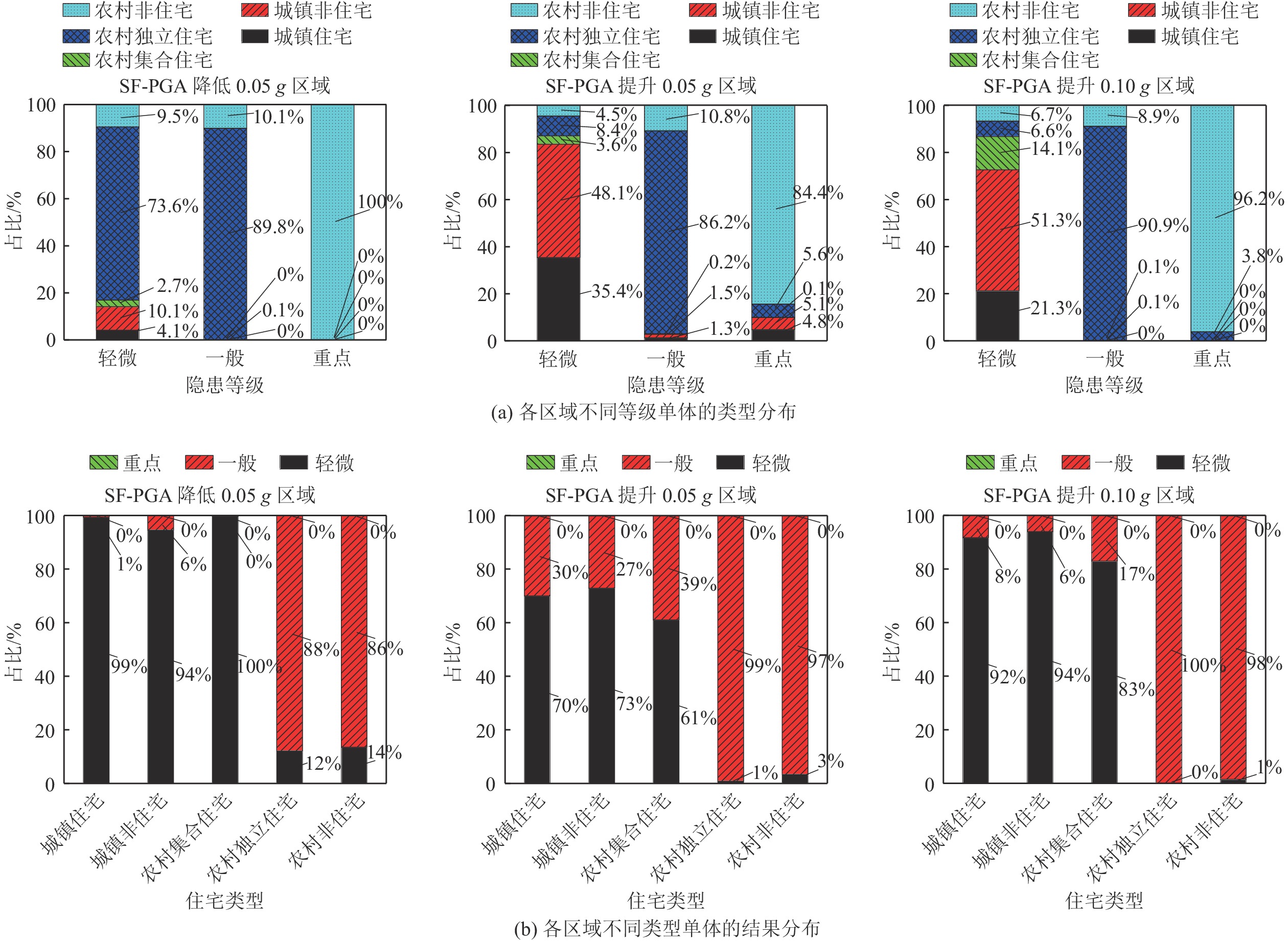Earthquake Hazard Assessment and Analysis of Influencing Factors Based on Census Data
-
摘要: 地震灾害隐患评估是第一次全国自然灾害综合风险普查涵盖的工作,随着地震灾害隐患评估工作的推进,多省市承灾体地震灾害隐患评估工作相继完成,为利用普查结果辅助有关部门有针对性地做出决策,需分析承灾体隐患评估的影响因素。基于第一次全国自然灾害综合风险普查项目建筑调查数据,首先统计分析某省级行政区内不同烈度区域及峰值加速度调整区内5类承灾体数量、抗震设防水平、变形损伤现状、建造年代等情况;其次采用隐患等级技术评定规范计算承灾体单体隐患指数,并给出不同类别区域地震灾害隐患等级;最后结合烈度调升及峰值加速度调整情况对隐患评定结果影响因素进行对比分析。研究结果表明,烈度和设防峰值加速度提升均会使承灾单体及区域隐患等级整体提高;农村建筑区域地震灾害隐患等级总体较高,其中农村非住宅为地震灾害重点隐患的主要承灾体;重点隐患单体中变形损伤的影响随抗震设防烈度的升高而降低,一般隐患等级单体中变形损伤及建造年代的影响随抗震设防烈度的升高而降低。Abstract: The earthquake hazard assessment of buildings is a task covered by the first national comprehensive risk census of natural disasters. As the work of earthquake hazard assessment progress, the earthquake hazard assessment of disaster-bearing buildings in many provinces and cities has been completed one after another. To utilize the survey results to assist relevant departments in making targeted decisions, it is necessary to analyze the influencing factors of disaster-bearing bodies and their importance. Based on the building survey data of the first national comprehensive risk census of natural disasters, this paper first statistically analyzes the number, seismic fortification level, deformation and damage status, and construction age of five types of disaster-bearing buildings in different seismic intensity areas and peak acceleration adjustment areas in a provincial administrative region. Secondly, it uses the technical evaluation specification of hazard level to calculate the hazard index of individual disaster-bearing buildings. Then, it gives the earthquake disaster hazard level of different types of regions. Finally, it compares and summarizes the influencing factors of the hazard assessment results based on the adjustment of seismic intensity and peak acceleration. The results show that with the increase of intensity and the increase of peak acceleration of fortification, the hazard level of buildings and regions will increase overall. In terms of category distribution, the overall hazard level of earthquake disasters in rural buildings is relatively high, among which rural non-residential buildings are the main category of disaster-bearing buildings with major earthquake disaster hazards. In terms of influencing factors, the impact of deformation and damage on key hazard individuals decreases with the increase of seismic fortification intensity, while the impact of deformation and damage and construction age on general hazard individuals decreases as the seismic fortification intensity increases.
-
表 1 承灾体单体的地震灾害隐患等级
Table 1. Earthquake hazard levels for the single building
隐患等级 承灾体地震灾害隐患指数IPEH 轻微 (0.25, 1.0] 一般 (0.075, 0.25] 重点 (0, 0.075] 表 2 区域分类地震灾害隐患等级
Table 2. Earthquake hazard levels with region Classification
隐患等级 区域分类地震灾害隐患指数$ {J}_{\mathrm{P}{{\mathrm{E}}}\mathrm{H}i} $ 轻微 $ {J}_{\mathrm{P}{{\mathrm{E}}}\mathrm{H}3}\leqslant 0.01 $且$ {J}_{\mathrm{P}{{\mathrm{E}}}\mathrm{H}2}+{J}_{\mathrm{P}{{\mathrm{E}}}\mathrm{H}3}\leqslant 0.1 $ 一般 $ 0.01 < {J}_{\mathrm{P}{{\mathrm{E}}}\mathrm{H}3}\leqslant 0.1 $或$ 0.1 < {J}_{\mathrm{P}{{\mathrm{E}}}\mathrm{H}2}+{J}_{\mathrm{P}{{\mathrm{E}}}\mathrm{H}3}\leqslant 0.5 $ 重点 $ {J}_{\mathrm{P}{{\mathrm{E}}}\mathrm{H}3} > 0.1 $或$ {J}_{\mathrm{P}{{\mathrm{E}}}\mathrm{H}2}+{J}_{\mathrm{P}{{\mathrm{E}}}\mathrm{H}3} > 0.5 $ 表 3 不同抗震设防烈度区域单体地震灾害隐患评估结果
Table 3. Evaluation results of earthquake hazard for single building in different intensity areas
区域 隐患等级 城镇住宅/栋 城镇非住宅/栋 农村集合住宅/栋 农村独立住宅/栋 农村非住宅/栋 总计/栋 占比/% 6度区 轻微 228 085 333 589 19 356 4 829 737 506 691 5 917 458 95.1886 一般 2 068 8 685 68 228 831 59 349 299 001 4.8098 重点 5 8 0 7 81 101 0.00 16 总计 230 158 342 282 19 424 5 058 575 566 121 6 216 560 100.0000 7度区 轻微 526 720 747 820 50 046 81 923 66 868 1 473 377 9.5040 一般 139 841 197 253 19 701 11 939 759 1 731 396 14 027 950 90.4867 重点 71 120 1 77 1 175 1 444 0.00 93 总计 666 632 945 193 69 748 12 021 759 1 799 439 15 502 771 100.0000 8度区 轻微 118 268 125 824 23 040 65 477 20 348 352 957 7.0962 一般 9 174 10 942 87 4 144 155 455 655 4 620 013 92.8854 重点 33 50 0 34 798 915 0.0184 总计 127 475 136 816 23 127 4 209 666 476 801 4 973 885 100.0000 表 4 不同抗震设防烈度区内区域分类地震灾害隐患评估结果
Table 4. Evaluation results of potential earthquake hazards in different intensity zones with regional classification
区域 城镇住宅 城镇非住宅 农村集合住宅 农村独立住宅 农村非住宅 总体 6度区 轻微 轻微 轻微 轻微 一般 轻微 7度区 一般 一般 一般 重点 重点 重点 8度区 轻微 轻微 轻微 重点 重点 重点 表 5 SF-PGA调整区域单体地震灾害隐患评估结果
Table 5. The evaluation results of individual earthquake hazard in SF-PGA adjustment area
区域 隐患等级 城镇住宅/栋 城镇非住宅/栋 农村集合住宅/栋 农村独立住宅/栋 农村非住宅/栋 总计/栋 占比/% 降低0.05 g区 轻微 943 2 318 611 16 853 2 168 22 893 14.3452 一般 6 135 2 122 667 13 861 136 671 85.6410 重点 0 0 0 0 22 22 0.0138 总计 949 2 453 613 139 520 16 051 159 586 100.0000 提升0.05 g区 轻微 283 539 385 076 28 786 67 248 35 529 800 178 7.6920 一般 121 653 143 678 18 395 8 272 384 1 045 427 9 601 537 92.2981 重点 49 52 1 58 868 1 028 0.0099 总计 405 241 528 806 47 182 8 339 690 1 081 824 10 402 743 100.0000 提升0.10 g区 轻微 1 623 3 907 1 070 506 509 7 615 1.9828 一般 147 252 220 342 081 33 693 376 393 98.0037 重点 0 0 0 2 50 52 0.0135 总计 1 770 4 159 1 290 342 589 34 252 384 060 100.0000 表 6 SF-PGA调整区域地震灾害隐患评估结果
Table 6. Evaluation results of regional earthquake hazard in SF-PGA adjustment areas
区域 城镇住宅 城镇非住宅 农村集合住宅 农村独立住宅 农村非住宅 总体 降低0.05 g区 轻微 轻微 轻微 重点 重点 重点 提升0.05 g区 重点 重点 一般 重点 重点 重点 提升0.10 g区 一般 轻微 一般 重点 重点 重点 表 7 各区域隐患等级对应影响因素
Table 7. Influencing factors corresponding to hazard levels in each region
区域 隐患等级 数量占比/% 抗震设防
达标占比/%存在明显
变形损伤占比/%1989年前 1990—1999年 2000—2010年 2011年后 6度区 重点隐患 100.0 0.0 0.0 0.0 0.0 100.0 一般隐患 47.15 26.76 19.28 6.81 1.2 76.37 7度区 重点隐患 86.08 8.86 3.67 1.39 0.0 52.84 一般隐患 32.55 29.6 27.43 10.42 0.06 3.79 8度区 重点隐患 92.9 2.62 2.62 1.86 0.0 23.72 一般隐患 24.37 30.96 26.94 17.73 0.18 4.93 降低0.05 g区 重点隐患 95.45 0.00 4.55 0.00 0.00 18.18 一般隐患 41.71 26.45 20.18 11.66 0.04 3.14 提升0.05 g区 重点隐患 87.45 7.49 3.40 1.66 0.19 41.44 一般隐患 24.97 30.83 31.13 13.07 0.21 3.97 提升0.10 g区 重点隐患 92.31 7.69 0.00 0.00 0.00 23.08 一般隐患 27.18 31.84 29.51 11.47 0.05 4.97 表 8 各烈度区分类承灾体地震灾害隐患影响因素
Table 8. Earthquake hazard influencing factors of buildings classified with intensity region
区域 类别 设防烈度达标占比/% 无病害占比/% 存在明显变形损伤占比/% 建造年代1989年之前占比/% 6度区 城镇住宅 97.43 24.10 0.66 14.62 城镇非住宅 91.12 24.78 0.45 9.34 农村集合住宅 99.57 95.03 0.53 4.50 7度区 城镇住宅 61.69 24.40 0.87 16.67 城镇非住宅 53.5 25.21 0.62 9.20 农村集合住宅 63.92 93.73 0.46 6.01 8度区 城镇住宅 93.4 29.88 0.75 9.33 城镇非住宅 91.23 33.06 0.69 7.28 农村集合住宅 99.87 96.48 0.47 3.11 -
柏文,杨永强,戴君武等,2021. 四川长宁 M S6.0级地震珙县中学教学楼震害调查. 地震工程与工程振动,41(3):86−94.Bai W., Yang Y. Q., Dai J. W., et al., 2021. Earthquake investigation of the teaching building in Gongxian middle school during the M S6.0 Changning earthquake. Earthquake Engineering and Engineering Dynamics, 41(3): 86−94. (in Chinese) 陈洪富,戴君武,孙柏涛等,2011. 玉树7.1级地震人员伤亡影响因素调查与初步分析. 地震工程与工程震动,31(4):18−25.Chen H. F., Dai J. W., Sun B. T., et al., 2011. Investigation report on influence factors of casualties in April 14, 2010 Yushu earthquake. Earthquake Engineering and Engineering Vibration, 31(4): 18−25. (in Chinese) 戴君武,柏文,周宝峰等,2022. 从泸定6.8级地震看建筑隔震技术发展亟待解决的问题. 地震工程与工程振动,42(6):1−11.Dai J. W., Bai W., Zhou B. F., et al., 2022. Urgent problems need to be solved in the development of seismic base isolation for buildings from the Luding M S6.8 earthquake. Earthquake Engineering and Engineering Dynamics, 42(6): 1−11. (in Chinese) 顾泺怡,路建波,朱奕非,2024. 浙江省体育场馆地震灾害风险隐患评估分析及探讨. 地震科学进展,54(5):311−315.Gu L. Y., Lu J. B., Zhu Y. F., 2024. Analysis and discussion on potential earthquake hazards of gymnasiums in Zhejiang Province. Progress in Earthquake Sciences, 54(5): 311−315. (in Chinese) 郭红梅,赵真,张莹等,2021. 一种适用于山地地区的地震灾害风险评估方法−−以四川省宝兴县为例. 灾害学,36(3):147−152. doi: 10.3969/j.issn.1000-811X.2021.03.025Guo H. M., Zhao Z., Zhang Y., et al., 2021. Study on quantitative assessment and classification method of earthquake disaster risk: a case study of Baoxing county. Journal of Catastrophology, 36(3): 147−152. (in Chinese) doi: 10.3969/j.issn.1000-811X.2021.03.025 郭小东,石占齐,卢继文等,2024. 石窟寺地震灾害风险评估方法研究−−以云冈石窟为例. (2024-03-15)[2024-05-07]. http://kns. cnki. net/kcms/detail/11.2068. TU. 20240314.2105. 002. html.Guo X. D. ,Shi Z. Q. ,Lu J. W. ,et al. ,2024. Study on risk assessment method of earthquake disaster in grotto temple-taking Yungang Grottoes as an example. (2024-03-15)[2024-05-07]. http://kns. cnki. net/kcms/detail/11.2068. TU. 20240314.2105. 002. html.(in Chinese). (in Chinese) 何巧灵,马玉飞,赵民等,2022. 济南市城镇既有房屋建筑抗震性能普查工作的实施及应用. 城市勘测,(1):192−195. doi: 10.3969/j.issn.1672-8262.2022.01.045He Q. L., Ma Y. F., Zhao M., et al., 2022. Study on seismic performace survey technology of existing buildings in Jinan city. Urban Geotechnical Investigation & Surveying, (1): 192−195. (in Chinese) doi: 10.3969/j.issn.1672-8262.2022.01.045 李姜,张合,刘志辉,2021. 张家口地区精细化地震灾害风险评估. 震灾防御技术,16(1):134−145. doi: 10.11899/zzfy20210114Li J., Zhang H., Liu Z. H., 2021. Refined risk assessment of earthquake disaster in Zhangjiakou area. Technology for Earthquake Disaster Prevention, 16(1): 134−145. (in Chinese) doi: 10.11899/zzfy20210114 马小平,朱瑞,孙艳萍等,2023. 基于建筑物详查的地震灾害重点隐患风险评估−−以临夏州为例. 地质论评, 69 (S1):509−511.Ma X. P. , Zhu R. , Sun Y. P. , et al. , 2023. Risk assessment of key hidden dangers of earthquake disaster based on detailed building survey--An example of Linxia City. Geological Review, 69 (S1): 509−511. (in Chinese) 潘毅,彭鑫,王腾等,2024. 泸定6.8级地震医疗建筑震害调查与分析. 建筑结构学报,45(5):14−29.Pan Y., Peng X., Wang T., et al., 2024. Seismic damage investigation and analysis of hospital buildings in M S6.8 Luding earthquake. Journal of Building Structures, 45(5): 14−29. (in Chinese) 全国自然灾害综合风险普查技术总体组,2020. 全国自然灾害综合风险普查工程(一)开展全国自然灾害综合风险普查的背景. 中国减灾,(1):42−45. doi: 10.3969/j.issn.1002-4549.2020.01.011 韶丹,田勤虎,张炜超等,2023. 陕西省神木市建筑物地震灾害隐患评估. 地震研究,46(3):440−445.Shao D., Tian Q. H., Zhang W. C., et al., 2023. Evaluation of potential earthquake-hazard of buildings in Shenmu city, Shaanxi province. Journal of Seismological Research, 46(3): 440−445. (in Chinese) 史铁花,王翠坤,郭浩等,2024. 基于普查的既有建筑抗震隐患评价技术研究. (2024-01-13)[2024-05-07]. https://doi. org/10.19701/j. jzjg. 20232447.Shi T. H. ,Wang C. K. ,Guo H. ,et al. ,2024. Research on seismic hazard assessment technology for existing buildings based on census. (2024-01-13)[2024-05-07]. https://doi. org/10.19701/j. jzjg. 20232447. (in Chinese) 孙柏涛,张桂欣,2017. 中国大陆建筑物地震灾害风险分布研究. 土木工程学报,50(9):1−7.Sun B. T., Zhang G. X., 2017. Study on seismic disaster risk distribution of buildings in China’s mainland. China Civil Engineering Journal, 50(9): 1−7. (in Chinese) 王东明,高永武,2019. 城市建筑群概率地震灾害风险评估研究. 工程力学,36(7):165−173.Wang D. M., Gao Y. W., 2019. Study on the probabilistic seismic disaster risk assessment of urban building complex. Engineering Mechanics, 36(7): 165−173. (in Chinese) 杨格格,杨艳昭,游珍等,2011. 中国陆域地震灾害的时空分布格局. 地球科学进展,26(5):548−555.Yang G. G., Yang Y. Z., You Z., et al., 2011. The temporal and spatial distribution pattern of earthquake disaster in Chinese mainland. Advances in Earth Science, 26(5): 548−555. (in Chinese) 杨永强,柏文,戴君武等,2023. 四川长宁Ms6.0级地震建筑震害调查与分析. 建筑结构,53(S2):738−743.Yang Y. Q., Bai W., Dai J. W., et al., 2023. Investigation and analysis of building damage caused by M S6.0 Changning earthquake in Shichuan ProVince. Building Structure, 53(S2): 738−743. (in Chinese) 张桂欣,孙柏涛,陈相兆等,2018. 北京市建筑抗震能力分类及地震灾害风险分析. 地震工程与工程振动,38(3):223−229.Zhang G. X., Sun B. T., Chen X. Z., et al., 2018. Seismic capacity classification of buildings and seismic disaster risk analysis in Beijing City. Earthquake Engineering and Engineering Dynamics, 38(3): 223−229. (in Chinese) 赵东升,靳京,吴绍洪,2022. 区域地震灾害房屋脆弱性曲线构建研究. 自然灾害学报,31(1):127−136.Zhao D. S., Jin J., Wu S. H., 2022. Research on regional seismic vulnerability curves of buildings in China. Journal of Natural Disasters, 31(1): 127−136. (in Chinese) -




 下载:
下载:



